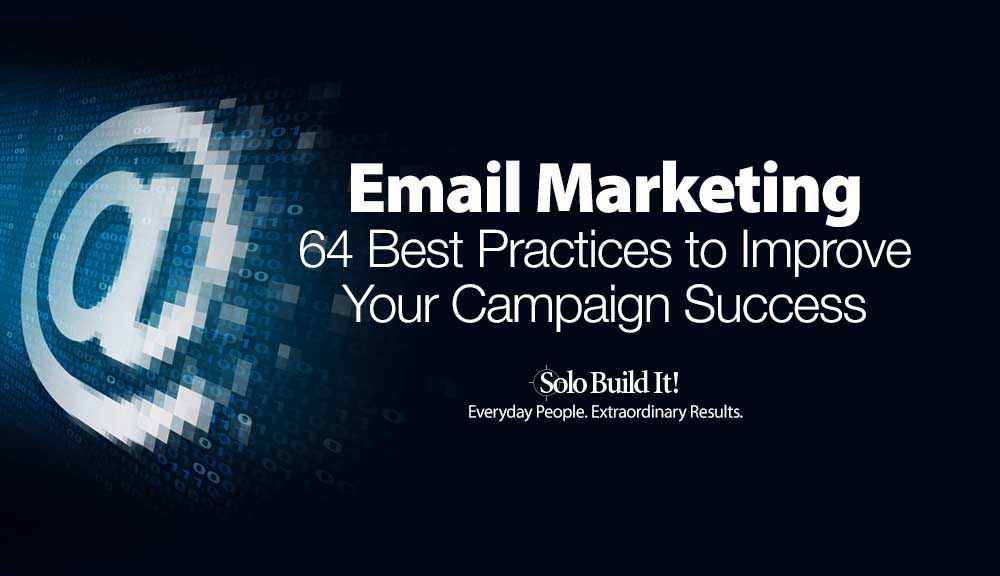
Email marketing best practices can help you get results for your online business, no matter how small you’re starting out.
It’s not just the size of your list that matters. It’s also how excited, engaged, and responsive your subscribers are. If you have a list of 100,000 people but only 5 percent of them open your emails, you have an active list of only 5,000 people.
And if, of those 5,000, only 1% are prepared to buy, in reality, you have a list of only 50 people.
And if the open rate drops with each email you send, the engaged number falls even more.
The excitement wears off. Subscribers unsubscribe. You begin to feel despondent.
Don’t.
Building an email list is about building a relationship with every subscriber. Building trust in you and your brand.
Using the very best email marketing practices can help build that trust.
Here are 64 email marketing tips you can put into practice right now.
However, if you’re not yet at that stage, we have an article to help get you there: how to grow your email list from scratch. Read it now, follow the steps and come back here when you’re ready for more advanced tips.
Creating an Email Marketing Plan Before You Start
You may want to plow straight ahead. It’s understandable, but in the long term, it’s unlikely to be successful.
Success is in the planning. Your aim here is to think carefully through a strategy. Step back. Consider what best practice means for your niche, your potential subscribers.
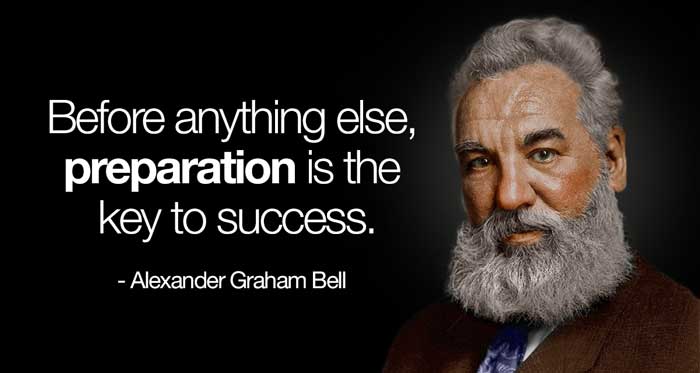
Here’s where we begin the tips that will begin improving your email marketing campaigns.
Don’t try to implement everything at once. Choose one tip you think is achievable quickly. Implement it. Check it off the list. Move on to the next. If a tip doesn’t seem to apply to you, set it aside and return to it later.
When you’ve implemented everything you can, schedule time to go through the list again later, including some you skipped and improving those you used.
1. Realize it’s not all about you.
Be honest: have you been writing anything that comes into your head, just to get that newsletter out on time?
That’s a mistake.
You’re not writing for you. You’re writing for your potential subscribers. Get rid of any preconceived ideas about their needs. Keep an open mind, and be prepared to go back to square one to learn about them.
2. Know your subscribers.
Every email address you collect represents a person. Knowing that person, and growing your knowledge, must be at the core of everything you do in your email marketing. It’s key to building trust, which is the key to that person actively wanting to open your emails.
Not sure where to start? This article on writing effective product reviews covers the basics of getting to know your customer.
3. Always put your customer first.
Every email, automation and newsletter must have your customer at its core. Ask the question in everything you write: “How is this serving my subscribers?” That way lies the key to higher open rates.
4. Plan your email marketing strategy.
Knowing what you’re trying to achieve is essential — and often overlooked. Your goals will change over time, so set them now and schedule a date to review in 6 months or at an additional 500 subscribers — whichever comes first.
5. Make your goals specific, realistic and time-limited.
For example, if you’re just starting out with email marketing, your goal might look like this:
“I will increase subscribers to my list by 500 in the next 6 months. I will do this by rewriting my lead magnet to better target my subscribers’ needs.”
If you’re further down the road, it might be:
“I will increase sign-ups to my ecourse by 5% in the next three months. I will do this by segmenting my subscribers and sending them a specifically targeted free ‘taster’ course.”
Take 30 minutes now to identify goals for your email marketing campaign over the next 3 months.
6. Don’t be average!
Your aim is to find people who will look forward to your emails. Make an agreement with yourself now that every email you send will be planned, targeted and well composed.
If you always deliver above-average email content, your open rates will improve and your unsubscribe rates will fall.
Designing an Effective Email Signup Box
Take a look at your signup box now. It’s one of the most important elements of your email marketing campaign.
How does it measure up?
Here are some tips to increase your subscribers by setting up an effective optin form on your website.
7. Keep your signup box clean and uncluttered.
Your main aim is for the reader to become a subscriber. Don’t distract with unnecessary images or information — put that on the landing page itself.
8. Ask only for the information you need.
The less the subscriber has to enter, the better:
- If the signup is for a newsletter, ask for first name and email address.
- If you’re a service provider — a plumber, for example — you may also need a physical address and telephone number.
- If you’re a counsellor, you may need details about the potential client’s problem areas.
9. Use a creative call to action.
Forget “Sign Up” or worse, “Click Here.”
Go for an action phrase like “Send me my free ebook!” Or “I’m In!” — whatever will resonate with your audience.
Using such “power words” can increase your signups by as much as 12%.
Take a look at Marie Forleo’s signup box for her newsletter. Could it be any simpler?
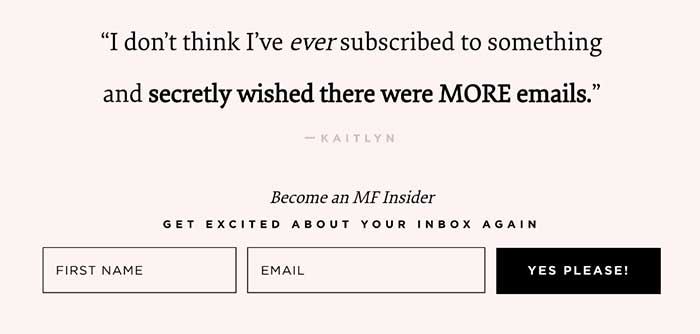
- A great quote from a subscriber!
- An appeal to the emotion: “Get excited about your inbox again.”
- Sign up first name and email address only.
- Call to action suited to her target audience.
10. Consider signups on the go.
If you go to conferences or trade shows, consider the potential for colleagues or visitors as subscribers. They’re at an event about your niche subject, and they’re keen — they’ve decided to attend and possibly traveled a long way to get there. They’re already warmed up.
You can use an app to sign them up to your email list on the spot. AWeber, for example, has “Atom,” which allows new subscribers to enter their information on your mobile device, or on a tablet you set up specifically for the purpose.
Using a digital signup in person is in keeping with the law — they’re entering their own data freely — and there are no messy scraps of paper to deal with later!
11. Stay within the law.
GDPR regulations apply to anyone who collects data from any European Union citizen — no matter where you’re based. Most email service providers now have a simple checkbox solution, and a means for subscribers to view and change their data.
12. Make sure you have explicit, verifiable consent from the subscriber.
Adding the name and email of someone who gave you their card at an event is not enough. In any event, it’s likely to lead to an immediate unsubscribe and, potentially, a complaint.
Make sure your email software uses a double opt-in so that new subscribers receive an email asking them to confirm — before they start receiving marketing emails.
Encourage Engagement with a Compelling Lead Magnet
Your lead magnet is the key not only to attracting subscribers, but attracting the right subscribers: those people who are interested in what you have to share with them and putting it to use.
Assess your lead magnet now, particularly if you designed it some time ago. If you don’t yet have a lead magnet, use these tips to create an effective one.
13. Create a lead magnet that solves your reader’s main problem, need or desire.
What is your audience’s main issue, and how does your current lead magnet measure up as a solution?
Email marketing best practices include always thinking about how your products and freebies help your potential customer.
14. Keep your lead magnet short.
Time was when lead magnets were 50-page ebooks (or longer!). Now, consumers want something of value that they can digest quickly and easily.
The more easily subscribers can absorb the information, the more perceived benefit they receive.
15. Make it stand out.
Don’t regurgitate information your reader could find on dozens of other blogs in your niche. Give it your own “spin.”
16. Make lead magnets immediately actionable.
The reader must be able to see an immediate benefit. That way, they’ll know to expect the same from your emails.
Case Study: Email marketing best practices for lead magnets
One of the most popular sections of my website concerns how to get rid of rats, which can become a massive problem for backyard chicken owners.
The free giveaway for that section is a simple downloadable checklist that guides readers through the steps needed to check for and deal with vermin in their chicken coop.
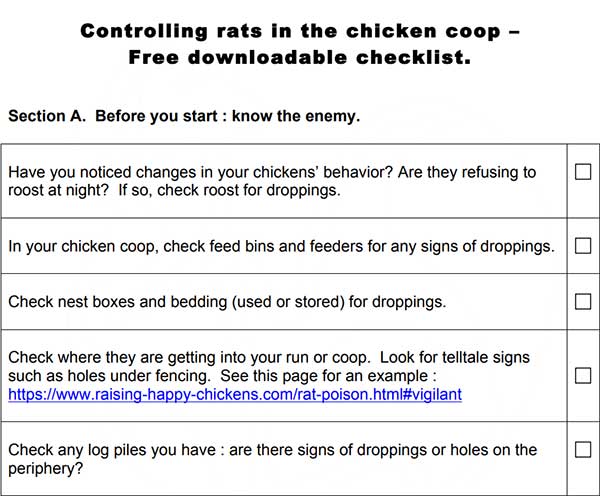
When readers subscribe, they check a box on the signup form indicating they’re happy also to receive my newsletter, thereby covering GDPR legislation.
Email Marketing Best Practices for Landing Pages
The aim of the landing page (or pages, if you have more than one signup, for example a newsletter and an ecourse) is to begin building the all-important rapport that will convert a reader into a subscriber. It’s also a crucial part of your email marketing funnel.
17. Write a clear headline for your email signup landing page.
Focus the headline of an email signup landing page on emphasizing a benefit the reader will get when she becomes a subscriber.
Find out more about what makes a good headline.
18. Use bullet points.
Use bullet points, rather than long sections of text, to describe exactly what subscribers can expect to receive, both in the lead magnet and in your emails.
Bombarding readers with blocks of text is likely to see them click away.
19. Add an image of your lead magnet.
To quickly demonstrate its benefits and exclusivity, add an image of your lead magnet to your landing page. Optimize the image for speed.
Email Marketing Best Practices for Mobile Devices
No one invested in email marketing can afford to ignore the dramatic increase in users of mobile technology. Virtually every report about email marketing finds that mobile devices account for at least 50% of open rates.
Mobile optimization is now critical to the success of your marketing campaigns. And it starts at your landing page. If users can’t see or load your page properly, they can’t sign up.
20. Test your email signup landing page on a mobile device.
Is it easy to read? Do the headlines and subheadings stand out? Is the text readable on a small device?
21. Make sure the email signup form looks good on a mobile device.
Does it render properly? Is it obvious as you scroll through the page? Is it easy to read? Does it look cluttered with too much information? Does it (ideally) fit onto one screen?
22. Make sure the fields (name, email address) are easy to complete.
Remember: the view on mobile devices is tiny compared with desktop view. Your field boxes must be easily seen, and accessible with the chunkiest of fingers!
23. Make the call to action (CTA) button large enough.
Make it easy for readers to tap that button and sign up to your email list!
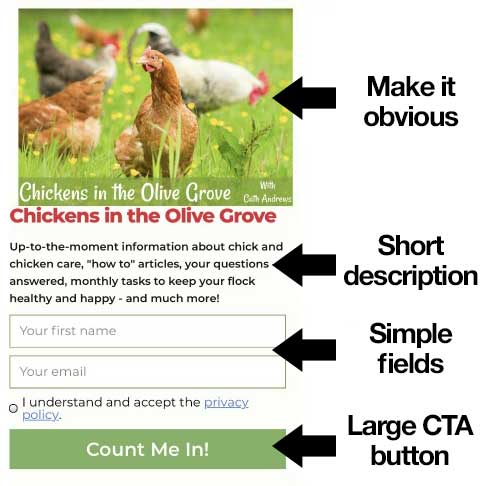
24. Ensure mobile users can download the lead magnet.
Make sure your lead magnet looks professional for readers who will download it on a mobile device.
Wherever possible, use PDFs rather than Word documents for text downloads (e.g., ebooks, checklists). PDF files are compatible across multiple platforms, so they’ll look more professional.
25. Test the process by signing up to your own email list.
Subscribing to your own list is a great way to test what’s working and what’s not.
We’ll cover the effects of mobile technology on other parts of your marketing practice as we move through the next sections.
Designing Your Email Marketing Campaign for Deliverability
Before you begin to consider what information your emails will contain, think about how you’ll construct them for maximum deliverability.
26. Be consistent in design to create a feeling of familiarity.
Branding emails with the same font, colors and voice as your blog helps readers easily recognize whose newsletter it is. If they immediately recognize the sender, subscribers are less likely to delete unopened, or mark your email as spam.
27. Reduce fancy design formatting to make your emails easy to read.
It’s tempting to rely on a template, which most email providers offer. It can save a lot of time. But would you really send a heavily designed email to a friend?
Concentrate on the content, not an all-singing, all-dancing template design.
28. Limit images to improve deliverability.
Image-heavy emails may end up in Google’s “Promotions” tab, meaning they won’t get as far as your subscriber’s inbox.
Mobile users don’t appreciate large files eating up their data allowance, and about 43% of subscribers block images altogether. If you use images, make sure they’re optimized and given “alt” text — or don’t use them at all.
After all, you probably rarely send images in an email to a friend.
29. Include links throughout each email to encourage clicks through.
Include in-text links as well as a specific call to action button. Place that final link on its own line, making it more likely to get the click from mobile users.
People clicking on the links in your emails is a sign of engagement, and helps deliverability in the long run.
30. Check spelling and grammar before you send any marketing email.
Check content for spelling and grammar errors to avoid damage to your brand.
You’d be surprised at the damage it can do — some people will take delight in calling you out on social platforms for the smallest error.
31. Send a test email to yourself.
Before you send it out to your list, always send yourself a test mail and look at it on both desktop and mobile devices.
Look at it from the eyes of a subscriber. Click and tap on all the links to make sure they work.
Best Practices for Using Email Automation
Before we get to some more advanced email marketing tips, let’s recap what we’ve covered so far:
You’ve planned a strategy and you’re keeping your subscriber at the forefront of your thinking. You’ve set up a landing page to address issues your readers want to hear, in language that resonates with them.
You’ve offered an excellent quality free download that provides information your readers want to know. They’ve filled in your simple, mobile-friendly, easy-to-use signup box.
You’ve also learned some email marketing best practices around design, and you test every single email before you send it.
Now what?
Send an automated sequence of welcome emails. This “welcome sequence” is your next chance to establish engagement by building a relationship. You’re allowing your subscribers to get to know you and your blog.
A large percentage of subscribers who unsubscribe do so because they don’t remember signing up for your emails. Some will even report them as spam.
Your job is to teach them to remember.
32. Send a welcome email right away.
Immediately after a reader subscribes to your emails, send her a personal welcome from you.
Use your email provider’s software to set up an automatic trigger while your email is fresh in the subscriber’s mind.
33. Provide the lead magnet link in your first email.
Use the welcome email to thank the reader for subscribing and to provide a link to download the lead magnet.
You can do this on a landing page, telling her exactly what she can expect to receive, and when. Let her know how she can contact you.
And then, tell her she can expect some emails over the next few days to introduce her to your blog.
34. Set up an automated welcome series.
Now set up a series of up to five more automated emails, sent out at intervals over the next two to three weeks. Again, use your email provider’s automation capabilities.
This is your opportunity to highlight information on your blog that you know your subscriber will find useful to answer her pressing problems or questions.
35. Include high-quality, actionable information, every time.
Use these initial automated emails to create a habit.
Get your subscriber used to opening your mails. Make each message so full of high quality, immediately actionable information that she will actively want to open the next one.
Like Marie Forleo’s fan, make her secretly wish there were more!
36. Make it personal.
In the email subject line, use your provider’s script to add the subscriber’s first name. Write as if you’re speaking to an individual — because you are.
37. Tell your brand’s story.
Bring your business to life for your subscriber by showing her around your blog.
Think carefully about this: break your information into sections, and introduce one section in each email using links to different articles.
38. Plan email frequency to match the depth of content.
Consider how frequently you should send the emails in your welcome sequence. You’re trying to build a habit for your subscribers of opening your mails, but sending one a day, for example, may be too much for some audiences.
If your emails are short and to the point, one every two or three days is fine. If they’re full of dense information it will take time to digest, make them less frequent.
39. Keep the text simple.
It’s easy to get carried away, trying to drum up a sense of excitement. Your emails are likely to end up in the spam folder unless you resist the urge to add exclamation points, ALL CAPS, and emojis.
Deliver what you said you would deliver, and keep your “conducted tour” simple.
Remember: you’re aiming to build a relationship of trust. Don’t overdo it by acting like a bad car salesman.
Case Study: Email Automation Welcome Series
This is my autoresponder series, written in AWeber. The average open rate of these is 65%, which is higher than the industry average.
I send a total of 6 emails, with the first one going out immediately on subscription. The rest are sent automatically, at one or two day intervals. Each one introduces a different section of my website.
The {firstname_fix} tag tells the automation software to include the subscriber’s first name. The final email, “A chicken question,” asks my subscribers to write and tell me one thing they wish they’d known about keeping chickens when they started out.
That question in my final email engages subscribers by involving them in the emails. It also gives me a good idea of whether my content is hitting the mark, and often sparks great ideas for future articles.
The major benefit of an automated email series like this is it’s a “set and forget.” Write the emails once, program them to be sent, then get on with the rest of your work.
I review my automated sequence every six months to make sure the content is still fresh, adding new information as needed.
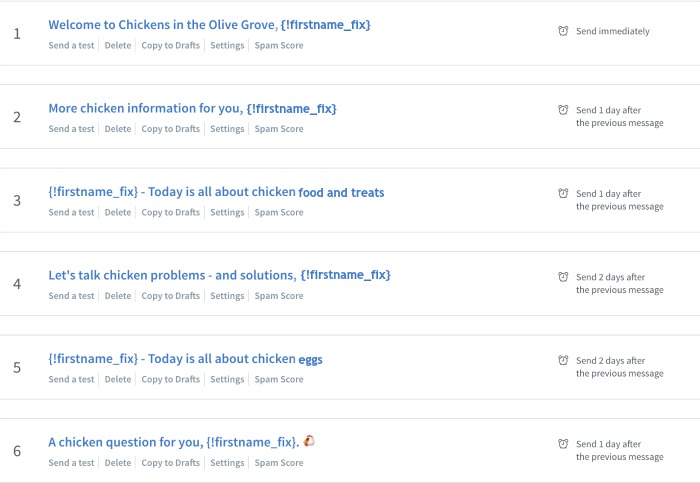
Email Newsletter Best Practices to Increase Retention
You’ve welcomed your subscribers and given them a “tour” of your blog. They’ve seen for themselves what you offer them.
Your aim now is retention: giving those people compelling reasons to stay on your list and open your emails. Here’s how to do that.
40. Include the subscriber’s first name in the subject line.
Including your subscriber’s first name in the subject line of an email can have a huge impact on open rates. It draws attention to your email in a crowded inbox.

41. Use punctuation in subject lines carefully.
Including a period (called a full stop in the UK) at the end of the subject line in no more than 4% of your emails can lead to an increase in deliverability of 0.5%, and in open rates of between 10% and 20%.
Adding an exclamation mark at the end of the subject line can increase open rates by between 1% and 20%.
On the other hand, using question marks at the end of a subject line can result in a drop of around 8%.
42. To capitalize or not to capitalize?
There’s a current trend to use all lowercase letters. Assess how your audience would react to that.
For example, a list of English teachers would be less likely to appreciate it than a group of trendy graphic designers!
43. Keep subject lines to fewer than 44 characters.
Between 14 and 24 characters and between 3 and 5 words is optimum according to OptinMonster’s research.
44. Don’t use a misleading or unclear subject line.
Make sure your subject line reflects what’s in your email, or at least your “top story.”
Using “clever” subject lines will mean your readers are likely to scroll past, unable at a glance to understand what’s in it for them.
And misleading subject lines are a complete no-no. They may get the click, but the emails are likely to end up in the spam folder.
45. Use emotion in your subject line.
Use words to evoke emotions such as curiosity, concern, pleasure, or distaste. One of my best open rates was from a subject line: “Got rats? You need to read this!”
46. Don’t “email blast” a subscriber. Write to a friend.
How would you normally address a subject line to a friend or family member?
Take into account all the email marketing tips that make sense to you, but remember the most important thing: email marketing best practices should aim to establish a relationship.
Best Practices for Email Content to Get Opens and Clicks
Do you panic the day before your newsletter is due about what to write, eventually sending out anything just to get it done? This section is for you!
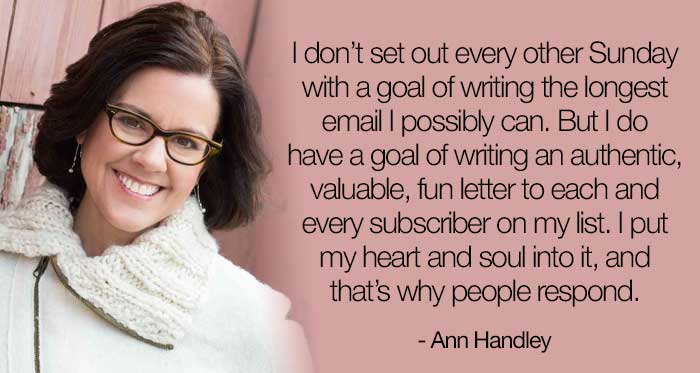
When the content is no longer relevant, people unsubscribe. And when you don’t feel confident that your emails are valuable to readers, it’s hard to stay motivated.
The answer is planning ahead — one of the best work habits for creating great email content.
47. Take time to plan every email.
Think about one goal for that email. Ask yourself what you’re trying to achieve, which content will get you there, and what your call to action will be.
48. Make your content unique and valuable.
If it’s information your readers can easily find elsewhere, you won’t get the click. Make sure you take the time to find useful, fresh, and relevant information to include in every email you send.
49. Recognize the benefit of seasonal content.
Think about slightly bizarre holidays as well as the well-known ones, when considering topics to cover in your newsletter.
Did you know, for example, that May 4th is International Respect for Chickens Day? Perfect for my monthly newsletter!
50. Marketing emails can sell without selling.
It may be called email marketing, but monetizing your email list really is about establishing connections. By all means, use your newsletter to promote your website or mention useful products — but always aim to evoke feelings, so your readers will be compelled to click across.
Here’s an example from my newsletter, using the little known Respect for Chickens Day. The link is to a product review of various different treats — and their storage solutions.
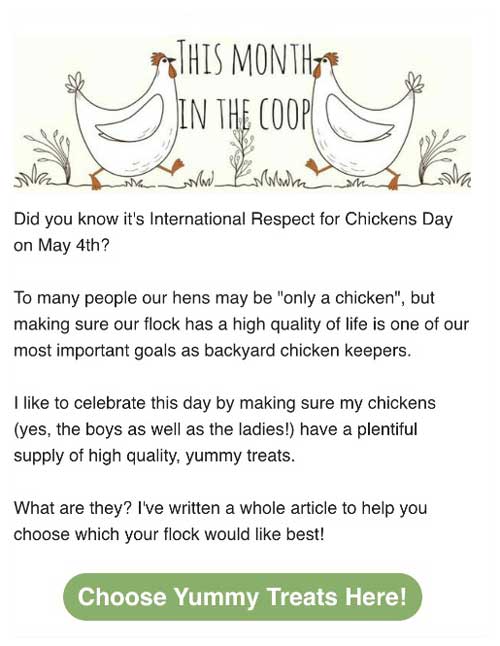
51. Get to the point.
You have about three seconds to engage a mobile user. Make it easy for the reader to do what you’d like her to do by keeping your main content and call to action near the top of the email.
52. Match email length to your goal and your audience.
For example, if you’re sending one quick, actionable tip to a busy executive, don’t dress it up in “fluff.”
On the other hand, if the goal of your email is to raise awareness and build relationships with retirees — and your content is relevant to their life — subscribers will read for longer.
Be aware, though, that Gmail clips content at 102 kilobytes. Subscribers will then see the dreaded message:
![]()
53. Include a call to action that highlights a benefit.
Make sure your call to action reflects the content of the page and provides a benefit to your subscribers.
Focus on the value your subscribers will get right now.
So your email campaigns are going out regularly and your subscriber list is growing nicely. Your subscribers seem to be enjoying the newsletters, but you’re getting some unsubscribes.
What might help?
Reduce Unsubscribes by Segmenting Your List
 Segmenting may sound complicated, but it’s simply a way of targeting your subscriber list more effectively.
Segmenting may sound complicated, but it’s simply a way of targeting your subscriber list more effectively.
Sending everyone on a large list exactly the same content can be counter-productive. Your aim is to give your audience individualized information they find relevant by dividing them into groups with similar characteristics or needs.
Here are some ideas and email marketing best practices for segmenting subscribers.
54. Ask for preferences in your welcome email.
In your initial welcome email, ask new subscribers what they are most interested in hearing about.
For example, if you have a recipe blog, it might make business sense to segment based on dietary styles like omnivore, vegetarian and vegan. Send emails containing only relevant content.
55. Ask subscribers how often they want to receive email.
You can segment your email list based on how often subscribers would like to hear from you.
For example, sending weekly emails to a busy mother of three who wants to hear from you monthly will make her more likely to unsubscribe — or even report your emails as spam.
56. Segment by engagement.
Subscribers who haven’t engaged with your campaigns for longer than (for example) three months can be segmented into an inactive group.
This enables you to send a separate campaign to re-engage this group. Re-engagement emails might focus more clearly on the positive benefits of staying on your list.
57. Segment your list based on purchases.
If you’re selling a product, segment people who have bought from those who haven’t. If you’re promoting an affiliate marketing program, you can segment based on who has clicked one of your affiliate links.
Someone who has bought once is more likely to buy again. Perhaps you’ll send that group more sales-focused campaigns than would go to the general list.
58. Segment by experience level.
Consider segmenting your email list by how much experience subscribers have in the topic you are writing about.
For example, if you have a quilting blog, you’re likely to have subscribers who are “old hands” and some who are beginners. Sending different campaigns with patterns for different levels of experience will keep everyone satisfied.
Email Best Practices for Unsubscribing
By law, every email must have an easy way for the subscriber to unsubscribe. Both the U.S. Federal Trade Commission and the E.U.’s General Data Protection Regulations require it, and all quality email providers will insist on this.
At first glance, unsubscribing may seem like a negative action — it’s never fun when someone decides to say goodbye. It can be a blow to the ego.
But there are ways to reduce unsubscribes, and lessons to be learned from them.
59. Test for improved retention rates.
Test different elements of your email marketing campaign to understand what works best for your audience and increases the rate of retention. Changing only one element at a time, use split testing to examine, for example:
- Personalizing your subject line vs not personalizing
- Images vs text only
- Long vs short content
- Call to action buttons vs linked text
- Send days and times
60. Check how often your subscribers want to hear from you.
People often unsubscribe because they get too many emails to read them all — both in general and from individual companies specifically.
There’s no magic answer to how often you should send emails. Subscribers will differ across different niches. The only way to be sure is to ask them directly, or allow them to opt in to different frequencies on your signup form or in your “welcome” automations.
61. Ask for feedback to improve your marketing strategy.
Give the option for people to provide a reason for unsubscribing. Allow them to connect with you easily to offer their thoughts and feelings.
If you’re active on social media for your business, include social media links so readers can contact you there. You can also add a “hit the reply” button with all your emails. Never send your emails from a “no reply” address.
62. Learn from negative feedback to increase the positive.
Do not be precious about hearing from your subscribers, even when they are leaving. No feedback is negative: it’s an opportunity to improve.
It may sting initially, but that’s probably because you recognize there’s some truth in it.
63. Prune your email list to remove inactive subscribers.
Clean your list, keeping only those who are engaged, to improve engagement. Most email providers charge according to numbers. Why add to your costs by keeping people on your list who are clearly never going to engage with you, let alone buy?
Here’s one way of doing it: please note this is for subscribers who are inactive. Those who have actively unsubscribed are dealt with below.
-
- Log in to your provider and filter subscribers to include only those who have not opened an email in the past 90 days.
- Send that segmented list a “gentle nudge” email asking if they want to carry on receiving your emails. Offer a simple call to action — perhaps a link saying either “yes” or “no.” This action segments the group into those who will remain on your list and those you’ll delete.
- If they don’t reply within the specified time, send another email. Make the second email more urgent than the first — but don’t be aggressive or unpleasant. You have no idea what may be going on in that person’s life.
- If there’s still no response, you have a choice. You can send one more email, or delete them from your list. If you decide to send another, make it clear that you’ll remove them from the list if there’s no reply within a week.
- Schedule this as a quarterly task to keep your list engaged and your open rates high.
64. Honor unsubscribe requests immediately to retain credibility.
Never charge a fee, send another email asking for reasons, or send any further issues of your newsletter or other communications to people who have unsubscribed. It’s against both FTC and GDPR regulations.
Make unsubscribing easy and obvious.
Wrapping Up Your Email Marketing Best Practices
So there you have it. 64 tips to improve your email marketing practices — plus a checklist to help you implement and review.
But there are only two main messages you need to remember:
- Be different. There are no rules for you or your subscribers. Every single list is different, unique. Try these tips, and remember: you’re not dealing with email by numbers. Keep testing to see what works for your audience.
- Be customer-driven at all times. Build a relationship. Improve subscribers’ lives wherever you can. Never regard your subscribers as a commodity, but as the heart of every campaign.
The words of Sir Richard Branson ring true here:

There are 64 tips and best practices in this article. It’s impossible to remember them all. To help, we’ve devised a free downloadable checklist for you to work with.
Don’t try to implement everything at once. Choose one tip you think is achievable quickly. Implement it. Check it off the list. Move on to the next. If a tip doesn’t seem to apply to you, leave it to one side and return to it later.
When you’ve implemented everything you can, schedule time to go through the list again at a later date, working on those you skipped and improving those you used.
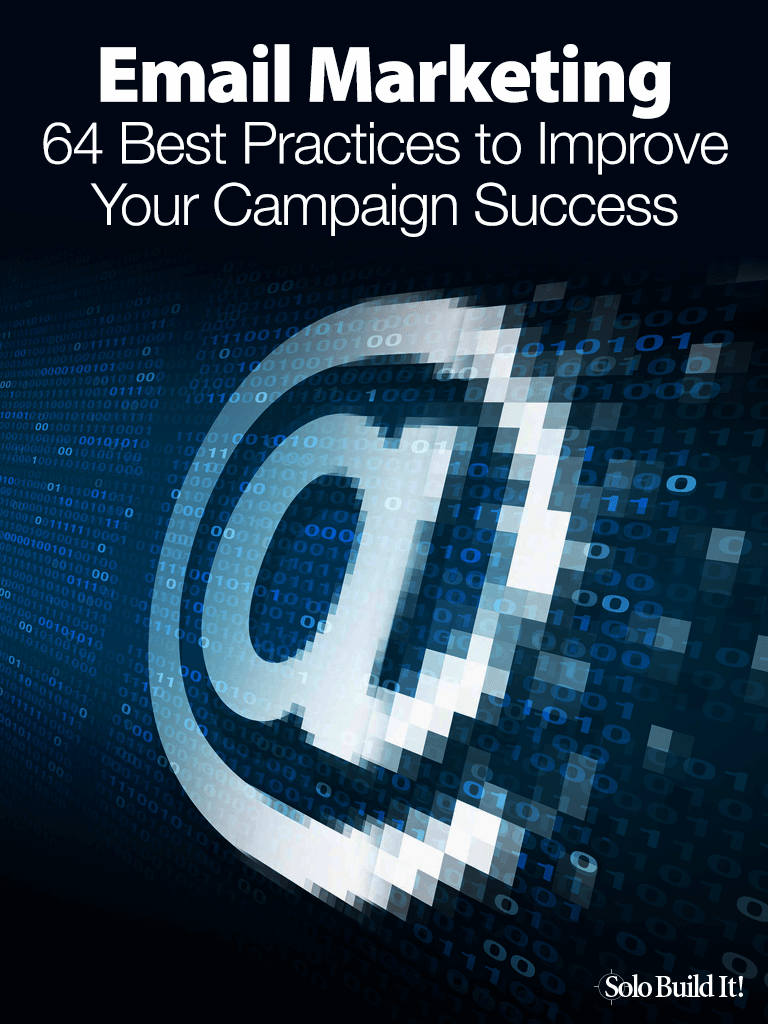
Cath Andrews
Latest posts by Cath Andrews (see all)
- Start a Passion-Based Business and Live Your Dream - February 1, 2023
- What Do You Say When Their Eyes Glaze Over? - December 20, 2021
- How to Monetize Your Email List in 5 Simple Steps - October 26, 2021

